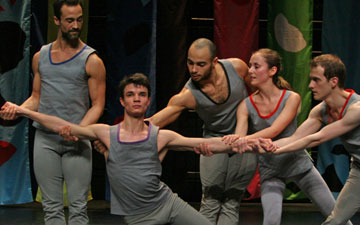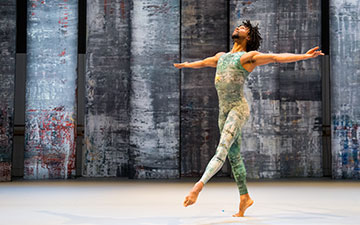
© Stephanie Berger. (Click image for larger version)
Merce Cunningham Trust
Night of 100 Solos: A Centennial Event
★★★★✰
New York, Brooklyn Academy of Music
16 April 2019
www.mercecunningham.org
www.bam.org
Entrances and Exits
When, shortly before Merce Cunningham’s death in 2009, it was announced that the company he had created in 1953 would close two years after his death, it came as a shock. Would the repertory survive without a company? Would these still-challenging works dissolve into the dance-history ether? I caught the very tail end of the company, and it took a few years for me to really feel the excitement of his work. Something snapped into focus at a performance at the Dia:Beacon, a museum upstate, where I could watch the dancers close-up. The difficulty, clarity, and unpredictability of the choreography kept me riveted. I found myself almost holding my breath. The dancers, elevated by their effort, left an indelible impression.
Ten years have now passed since Cunningham’s death, and eight since the company shut its doors, replaced by The Merce Cunningham Trust, which now preserves and licenses the works and runs Cunningham technique classes and workshops at New York City Center. This is also the centenary of his birth, marked by a crescendo in performances, the largest of which was this tripartite Night of 100 Solos, performed on the same day (Cunningham’s birthday) in New York, London, and Los Angeles. The three shows happened within hours of each other, with Livestreams making it possible to see them around the world. The videos will remain at https://www.mercecunningham.org/activities/night-of-100-solos/ for three months.
Night of 100 Solos was both a tribute and a massive act of transmission. None of the dancers – 75 in all, 25 in each city – had ever been a member of Cunningham’s company. Many had never taken a Cunningham class. I suspect, given the sped-up metabolism of the dance world, that many had never seen the company, or any Cunningham at all. Patricia Lent, the Trust’s director of licensing, and Jean Freebury, also a veteran of the company, put together a collage of overlapping solos drawn from the Cunningham repertory. Former company dancers taught them to this new generation of dancers. Each performed an average of four solos. (London and L.A. had different combinations of solos.) The performances were like a living anthology. Cunningham himself invented the idea of the “Event,” a performance of excerpts from other dances, shuffled around like cards. Cunningham’s Events usually lasted 20-30 minutes; this one was an hour and a half long.
Because of the nature of Cunningham’s choreography – disconnected from the music, randomized by chance procedures – I’ve always found it difficult to identify discrete passages from his dances. Night of 100 Solos was the same. I kept seeing bits and thinking, I’ve seen that before, but where? The only passage I could make out was a short jig-like dance from Roaratorio, a 1983 piece inspired by Irish dancing and James Joyce. (One of my favorites.) But the pleasure of Mercian “Events” is, in part, the way they re-invent the material. You see it anew, in conversation with a passage from a completely different dance. Contrasts of fast and slow, staccato and legato, hard and soft, even meter and syncopation, stimulate the eye and the mind. Each dancer is intensely focused on his or her own activity but exists in relation to the others. Sometimes this brings about surprising overlaps, echoes, or interactions. It’s a bit like watching different elements in nature interacting with a sense of purpose that is beyond our grasp. Cunningham was an avid nature-watcher; his dances are filled with bird-like motions: fluttering fingers, cocked heads, outstretched wings, sharp flicks.
In each city, the performers were drawn from across the local dance scene. New York’s cast included Sara Mearns of New York City Ballet – exciting, eccentric, sometimes wobbly, and a little wild. As well as Chalvar Monteiro of Alvin Ailey, incisive, stylish, intensely focused. Vicky Shick, a choreographer who spent years in Trisha Brown’s company, performed a series of quiet solos in which the simplest movement, like a bending of the knees combined with the lifting of an elbow, seemed to contain a multitude of secrets. The most impressive dancer, for me, was Peiju Chien-Pott, of Martha Graham; the Graham technique is well suited to Merce’s muscular, “held” carriage, the extreme bending of the torso, the endless balances in tilted positions. Reid Bartelme, a former ballet dancer who also performed with Lar Lubovitch (and designed the costumes), added notes of drama and humor, tearing across the stage only to come to a dramatic stop, flipping his hair to add an accent. (Cunningham purists be damned.) Jacquelin Harris, also of Alvin Ailey, was as technically impressive as I’ve ever seen her.
The visual design was spare. For the costumes, unitards of different lengths and rompers in vivid colors (by Reid Bartelme and Harriet Jung). For the backdrops, clichéd projections of water, ice, splashes of color (Pat Steir) I found myself intentionally ignoring the projections.
What impresses overall is the clarity of the technique; the precision and control it requires. And the way it enlarges the dancers, distilling their strengths, stretching them to the limit. With time, the choreography looks increasingly classical, structured, almost mathematical. The seriousness and concentration are leavened with moments of humor and absurdity. A man walks, laboriously, as if on a tight rope. There are endless variations on the silly walk, big, small, shuffling, slow-motion. A dancer dribbles an invisible ball. Another kneels on a chair while “swimming” with the other leg. Cunningham was a surrealist.
What does a person watching Merce for first time make of this inexplicable and sometimes eccentric compilation of movements? Frustration and incomprehension are perfectly understandable. A trickle of audience-members left the show – nothing new. And I’ll admit that at a certain point I did wonder whether 100 solos were perhaps too much of a good thing. A few too many entrances and exits.
This was also sometimes true of Cunningham’s evening-length pieces. But despite everything, they had a strong internal logic, a beginning, middle, and end. No Event can ever quite match the strong impression they created. Some help came from the pit; the music, performed live by David Behrman, Gelsey Bell, John King, Matana Roberts, and Jesse styles, created a series of crescendi, alternating with serene passages for the saxophone, voices, and electronica.
Then, just as I was beginning to get a second wind, the dancers returned, one by one, filling the stage, holding different positions, as if posing for a series of photographs. The curtain descended, and it was over. For those 90 minutes at BAM, Cunningham’s peaceable kingdom had returned.

















Marina Harss’ review of the Cunningham event in NYC was her usual excellence,
plus, and a mighty plus, her comments on arriving in the Cunningham universe towards the end of the artist;s career. A gem of an artist and equal brilliance in the appraiser.
And if I repeat myself, it’s still worth it.
Renée, you are too kind!